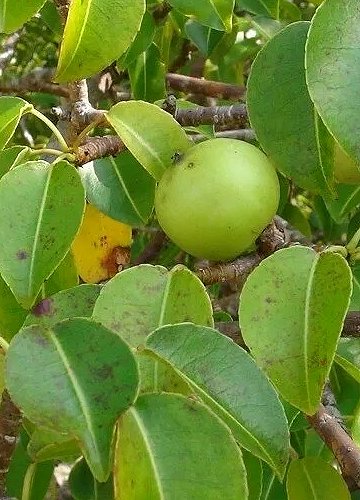
|
|
Tree of Death - Manchineel (Hippomane
mancinella). Leaves and fruit.
|
Tree of Death - Manchineel
- Hippomane mancinella
The manchineel tree (Hippomane mancinella) is a species of flowering plant in the spurge family (Euphorbiaceae).
Known as the most dangerous tree in the world because of
its toxicity. Its native range stretches from the sandy beaches and mangroves in tropical climates stretching from Florida to the Caribbean and down into parts of Central and South America.
The genus name Hippomane comes from two Greek words, hippo meaning “horse,” and mane, which is derived from mania and means “madness.” Theophrastus, an ancient Greek philosopher, gave the name Hippomane to a native plant in Greece after determining that horses became “crazy” after eating it. Linnaeus, the father of taxonomy, in turn gave the same name to this noxious tree from the Americas.
The name “manchineel” from the Spanish “manzanilla,” which means “little apple” in reference to the leaves and fruit of the apple tree (Malus spp.). However, due to its extremely toxic nature, the Spanish have also dubbed this tree “arbol de la muerte” meaning “tree of death” in reference to what happens to people if they eat the fruit. It is also called beach apple.
Hippomane mancinella is a glabrous, deciduous or evergreen tree with spreading branches and a rounded crown.
It grows up to 15 metres tall with a bole up to 90cm in diameter, but is usually smaller. It has reddish-grayish bark, small greenish-yellow flowers, and shiny green leaves. The leaves are simple, alternate, very finely serrated or toothed, and 5–10 centimetres (2–4 inches) long. Each leaf has a small gland where the leaf joins the stem.
Flowers are yellow green and inconspicuous, but the spikes or leafless stems that the flowers emerge from are visible.
Spikes of small greenish flowers are followed by fruits, which are similar in appearance to an apple,
are only 3–5 cm in diameter and are green or greenish-yellow when ripe. The fruit is poisonous, as is every other part of the tree.
Manchineel is native to the Caribbean, the U.S. state of Florida, the Bahamas, Mexico, Central America, and northern South America.
The manchineel tree can be found on coastal beaches and in brackish swamps, where it grows among mangroves. It provides excellent natural windbreaks and its roots stabilize the sand, thus reducing beach erosion.
This poisonous tree is considered as the most dangerous tree in the
world for its toxicity.
All parts of the tree contain strong toxins. Its milky white sap contains phorbol and other skin irritants, producing strong allergic contact
dermatitis.
Standing beneath the tree during rain will cause blistering of the skin from mere contact with this liquid: even a small drop of rain with the sap in it will cause the skin to blister. Burning the tree may cause ocular injuries if the smoke reaches the
eyes. Contact with its milky sap (latex) produces bullous dermatitis, acute keratoconjunctivitis and possibly large corneal epithelial
defects.
Although the fruit is potentially fatal if eaten, no such occurrences have been reported in the modern
literature. Ingestion can produce severe gastroenteritis with bleeding, shock, and bacterial superinfection, as well as the potential for airway compromise due to
edema.
When ingested, the fruit is reportedly "pleasantly sweet" at first, with a subsequent "strange peppery feeling ... gradually progress[ing] to a burning, tearing sensation and tightness of the throat." Symptoms continue to worsen until the patient can "barely swallow solid food because of the excruciating pain and the feeling of a huge obstructing pharyngeal
lump."
In some parts of its range, many trees carry a warning sign – for example on Curaçao – while others are marked with a red "X" on the trunk to indicate danger. In the French Antilles the trees are often marked with a painted red band roughly 1 metre (3 ft) above the
ground.
Although the plant is toxic to many birds and other animals, the black-spined iguana (Ctenosaura similis) is known to eat the fruit and even live among the limbs of the
tree.
The tree contains 12-deoxy-5-hydroxyphorbol-6-gamma-7-alpha-oxide, hippomanins, mancinellin, and sapogenin. Phloracetophenone-2,4-dimethylether is present in the leaves, while the fruits possess
physostigmine.
A poultice of arrowroot (Maranta arundinacea) was used by the Arawak and Taíno as an antidote against such
poisons. The Caribs were known to poison the water supply of their enemies with the
leaves. Spanish explorer Juan Ponce de León died shortly after an injury incurred in battle with the Calusa in Florida—being struck by an arrow that had been poisoned with manchineel
sap.
It has been documented that gum from the bark of this tree has been used to treat venereal disease and dropsy in Jamaica, while dried fruits have been used as a diuretic.
Although poisonous, an extract of the fruit is employed to treat elephantiasis.
Antidotes to the poisonous latex in an accidentally eaten fruit include: a leaf infusion of Jatropha multifida; a leaf-and-flower infusion of Tabebuia serratifolia; and a seed decoction of Fevillea cordifolia.
Despite the inherent dangers associated with handling it, the tree has been used as a source of wood by Caribbean furniture makers for centuries. It must be cut and left to dry in the sun to dry the sap. To avoid dangerous contact with the poisonous parts, the tree may be burnt at the base to fell it.
Source:
https://en.wikipedia.org/wiki/Manchineel
https://science.howstuffworks.com/life/botany/manchineel-tree.htm
https://edis.ifas.ufl.edu/publication/FR370
https://tropical.theferns.info/viewtropical.php?id=Hippomane+mancinella
